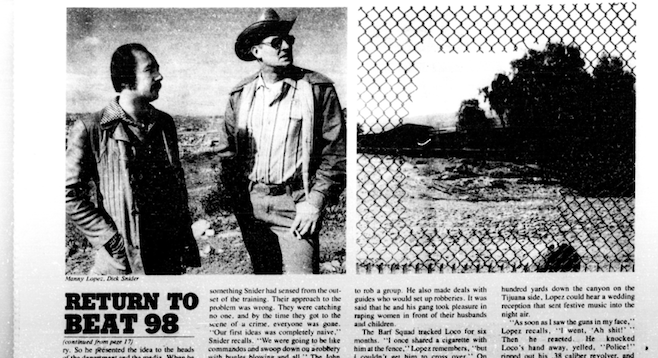 Facebook
Facebook
 X
X
 Instagram
Instagram
 TikTok
TikTok
 Youtube
Youtube

Teatro Mascara Magica’s Detained in the Desert runs through this weekend. The compelling play is about undocumented immigrants, a subject so vital they say the only way to see it fully is to be there. In effect, that’s what playwright Josefina Lopez does: she strands a man and a woman just inside the Arizona border and hounds them with the horrors of the desert.
In 1982 I wrote a story for the Reader -“Return to Beat 98.” Between 1976 and 1978, Manny Lopez led a 10-man volunteer police unit that patrolled the U.S./Mexico border. They went at night in search of gangs from both sides that did every imaginable evil to undocumented immigrants.
To pose as victims, Lopez and his team made themselves look undocumented: i.e. targets. They wore cheap clothes. At first they were too cheap – were obviously cops – and had to dress up for the job.
The result was many arrests and several shoot-outs in total darkness. During its 19 months of operation, the Border Crime Task Force reduced robberies by an estimated 28 percent (compared to previous reports).
In 1978, Police Chief Bill Kolander broke the group up. The assignment was “too dangerous.”
In 1982, Lopez, Police Lieutenant Dick Snider, and I spent an entire night at the border. We walked the mesa and down the canyons – E2 and the “Soccer Field” – and watched the shadows, some of which moved.
We watched people gather at sundown on the Mexico side of the fence. They sat in groups, waiting. All they owned was in small bundles or stuffed in pockets.
Around two a.m. we saw a guy I’ll never forget. He was strolling along the bare mesa on the American side, hands in pockets, as if, said Lopez, “he was going to a movie.” He was a pollero – the word for “guide” in those days – and calm as he could be.
“You understood how it felt to leave your home,” said Lopez, “then your country, just to find enough work so you could eat. And you knew what it’s like to have to run and duck and hide as long as you stayed in this country.”
One hope for the story was that it could become a movie. It never did. Joseph Wambaugh wrote a book, Lines and Shadows, but Hollywood stayed away.
Were the movie made these days it would highlight video game heroics – the deaths in blood-splattering slo-mo, to be sure - at the expense of those being raped, robbed, and killed.
“That’s why we wanted the movie made,” said Lopez. “Let the world see what they go through – see what’s happening on American soil. Then something maybe would get done.”
That was 31 years ago.
Maybe Detained in the Desert, which puts a human face on the issue, could become that movie.


Teatro Mascara Magica’s Detained in the Desert runs through this weekend. The compelling play is about undocumented immigrants, a subject so vital they say the only way to see it fully is to be there. In effect, that’s what playwright Josefina Lopez does: she strands a man and a woman just inside the Arizona border and hounds them with the horrors of the desert.
In 1982 I wrote a story for the Reader -“Return to Beat 98.” Between 1976 and 1978, Manny Lopez led a 10-man volunteer police unit that patrolled the U.S./Mexico border. They went at night in search of gangs from both sides that did every imaginable evil to undocumented immigrants.
To pose as victims, Lopez and his team made themselves look undocumented: i.e. targets. They wore cheap clothes. At first they were too cheap – were obviously cops – and had to dress up for the job.
The result was many arrests and several shoot-outs in total darkness. During its 19 months of operation, the Border Crime Task Force reduced robberies by an estimated 28 percent (compared to previous reports).
In 1978, Police Chief Bill Kolander broke the group up. The assignment was “too dangerous.”
In 1982, Lopez, Police Lieutenant Dick Snider, and I spent an entire night at the border. We walked the mesa and down the canyons – E2 and the “Soccer Field” – and watched the shadows, some of which moved.
We watched people gather at sundown on the Mexico side of the fence. They sat in groups, waiting. All they owned was in small bundles or stuffed in pockets.
Around two a.m. we saw a guy I’ll never forget. He was strolling along the bare mesa on the American side, hands in pockets, as if, said Lopez, “he was going to a movie.” He was a pollero – the word for “guide” in those days – and calm as he could be.
“You understood how it felt to leave your home,” said Lopez, “then your country, just to find enough work so you could eat. And you knew what it’s like to have to run and duck and hide as long as you stayed in this country.”
One hope for the story was that it could become a movie. It never did. Joseph Wambaugh wrote a book, Lines and Shadows, but Hollywood stayed away.
Were the movie made these days it would highlight video game heroics – the deaths in blood-splattering slo-mo, to be sure - at the expense of those being raped, robbed, and killed.
“That’s why we wanted the movie made,” said Lopez. “Let the world see what they go through – see what’s happening on American soil. Then something maybe would get done.”
That was 31 years ago.
Maybe Detained in the Desert, which puts a human face on the issue, could become that movie.
Comments